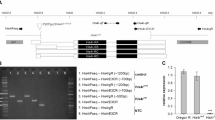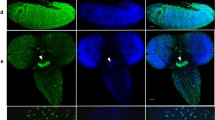Abstract
Position–effect variegation, originally observed in insects, has since been demonstrated in plants and mammals. When cells bear a chromosomal rearrangement which juxtaposes a euchromatic gene near to heterochromatin, a fraction of the cells exhibit no expression of that gene. The resultant organism is a mosaic for activity of the rearranged gene. The degree of mosaicism can be modified; such factors as elevated developmental temperature, additional Y chromosome heterochromatin in the genome, and various modifier genes enhance the proportion of cells in which the gene is active1. Although the phenomenon has been extensively documented, the underlying molecular mechanism of position–effect variegation remains unclear. The proportion of cells exhibiting gene inactivation increases with greater proximity of the rearranged gene locus to heterochromatin. It has been proposed that the variegating gene is inactivated by a ‘spreading effect’, or limited spatial diffusion of molecules from the adjacent heterochromatin2. This explanation supposes that the juxtaposed gene locus is condensed into a transcriptionally inactive state, possibly by a phosphorylated histone protein subspecies characteristic of Drosophila heterochromatin3. Such a model leads to the prediction that an alteration in the amount of cellular histone protein would affect the expression of variegating genes. To test this prediction, we have investigated the effect of a reduction in the number of genes coding for histone protein on the degree of mosaicism observed in two variegating gene systems. Our results suggest that the amount of variegating gene expression is a function of histone gene multiplicity.
This is a preview of subscription content, access via your institution
Access options
Subscribe to this journal
Receive 51 print issues and online access
$199.00 per year
only $3.90 per issue
Buy this article
- Purchase on Springer Link
- Instant access to full article PDF
Prices may be subject to local taxes which are calculated during checkout
Similar content being viewed by others
References
Spofford, J. B. in The Genetics and Biology of Drosophila Vol. 1c (eds Ashburner, M. & Novitski, E.) 955–1018 (1976).
Zuckerkandl, E. Biochimie 56, 937–954 (1974).
Blumenfeld, M. et al. Proc. natn. Acad. Sci U.S.A. 75, 866–870 (1978).
Pardue, M. L. et al. Chromosoma 63, 135–151 (1977).
Lifton, R. P. et al. Cold. Spring. Harb. Symp. quant. Biol. 1047–1051 (1977).
Wright, T. R. F., Hodgetts, R. B. & Sherald, A. F. Genetics 84, 267–285 (1976).
Ziegler, I. Adv. Genet. 10, 349–403 (1961).
Shoup, J. R. J. Cell Biol. 29, 223–249 (1966).
Bridges, C. Science 83, 210–211 (1936).
Brosseau, G. E. Jr Genetics 45, 979 (1960).
Khesin, R. B. & Liebovitch, B. A. Molec. gen. Genet. 162, 323–328 (1978).
Lindsley, D. L., Sandler, L. et al. Genetics 71, 157–184 (1972).
Brosseau, G. E. Jr Genetics 50, 237 (1964).
Hartmann–Goldstein, I. J. & Wargent, J. M. Chromosoma 52, 349–362 (1975).
Candido, E. P. M., Reeves, R. & Davie, J. R. Cell 14, 105–113 (1978).
Author information
Authors and Affiliations
Rights and permissions
About this article
Cite this article
Moore, G., Procunier, J., Cross, D. et al. Histone gene deficiencies and position–effect variegation in Drosophila. Nature 282, 312–314 (1979). https://doi.org/10.1038/282312a0
Received:
Accepted:
Issue Date:
DOI: https://doi.org/10.1038/282312a0
This article is cited by
-
Carnitine suppression of position-effect variegation in Drosophila melanogaster
Molecular and General Genetics MGG (1994)
-
Chromosomal structure is altered by mutations that suppress or enhance position effect variegation
Chromosoma (1990)
-
Random walking
Journal of Molecular Evolution (1990)
-
The genetics of position — effect variegation modifying loci inDrosophila melanogaster
Molecular and General Genetics MGG (1989)
-
Suppression of position-effect variegation inDrosophila melanogaster by fatty acids and dimethylsulphoxide: implications for the mechanism of position-effect variegation
Journal of Genetics (1989)
Comments
By submitting a comment you agree to abide by our Terms and Community Guidelines. If you find something abusive or that does not comply with our terms or guidelines please flag it as inappropriate.



